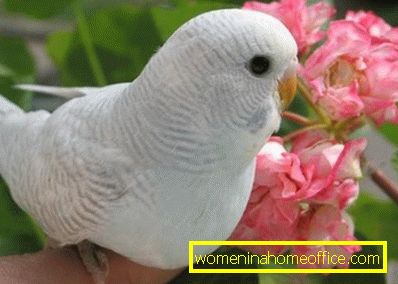How to teach a parrot to hands
09-09-2018
Home and hobby
Forso that the parrot stops being afraid of its owner, he must be one hundred percent sure that he does not pose any danger to him. Make it very difficult, but possible. The main thing is patience, consistency and regularity of actions performed.
Ways to teach a parrot to hands
- When you have just purchased a parrot and brought it into the house, put its cage in such a place so that it opens a good view. The cage set in the corner, as if to isolate your pet from the outside world, including from you. In this case, it will be hard teach a parrot to hands.
- The parrot cage should be quite spacious so that it can unfold its wings and fly freely from the perch to the perch.

- It is best to buy for the parrot such a drinker and feeder, so that they are attached from the outside. Thus, you will not disturb the bird once again. This is especially important at the very beginning, when you just had a bird.
- Arrange the cage with the parrot so that it can constantly see you and get used to you. In addition, the cell should be slightly above the level of your face. Thus, the parrot will become clear that you - the main. If you position the cage above the level of your face, it will be difficult to tame the parrot, it will not reckon with you, because it will think that it is more important, it is higher! And, if you put a cage with a parrot below the level of your face, looking to the parrot, you will, over and over again, “hang” over the cage, which will seem to the parrot as a danger and a threat.
- Cover the cage with a piece of material. But not completely. Leave the bird a small gap. This is necessary to ensure that the parrot is calm, so that he himself can choose the time to communicate with you. Especially at first the bird must have a certain angle in the cage, in which it can hide.
- During the first week after you brought the parrot home, do not start to accustom him to hands. Give him time so that he can successfully adapt to the new conditions for him.
- When you approach the cage, do not make any sudden movements and attacks. For a parrot, it's stress. It can get scared, and you will never be able to accustom the parrot to your hands.
- When you approach the cage to chat with your pet, be sure to give a voice. You can call the parrot by name, or say something to him. If, you will go to the cage silently, he will perceive you as a predator, who also creep in silence.
- Try to stay longer in his cage. Starting from the first day, and every day a little longer. Let the parrot get used to you. Let him know that you are not dangerous for him.

- Experimentally, try to find out what kind of treats your parrot prefers. And then use this delicacy as taming tool. First try to push the snack through the bars of the cage. When the parrot gets used to this ritual, try giving him a treat at the open door of his cage. When your pet grows bold, try putting your hand with a treat in its cage.
- When the parrot is no longer afraid to eat from your hand, you can try to pull it out of the cage. If you started to pull out your hand, and the parrot jumped off of it - do not worry! He is not yet ready for this. You can try to pull the parrot out of the cage with a pencil. Push him into the cage, and try to pull him out when the parrot is on him. Remember that you must not allow any sudden movements! Otherwise, it may happen that you have to start all over again.
- For each step forward in the process training your parrot to hands, Praise him and encourage him. He may not understand your words. But, by intonation, it will be clear to him that you are pleased with him.
- In no case can not scream at the parrot and apply physical force to it. This can scare him, and even be fatal.
- It is noticed that in the evening the parrots are more gullible to the person. Therefore it is possible gradually accustom the parrot to the hands, doing it in the evenings.
- Remember that parrots are vindictive birds. And, in the event that you cause him any harm, the bird will not forget about it. And on occasion, she will try to revenge you.

- When your parrot starts to try the treat from his hand, he may, before entering your fingers, peck at them a little. Do not withdraw, in any case, hand! Thus, your birdie only checks how reliable the support is.
- When talking with your parrot, make sure that your voice is gentle, intonation is calm. Do not forget the smile!
If you are patient and gentle enough for your pet, if you follow all the instructions exactly, you can to accustom the parrot to hands in a fairly short time.
If you are just thinking about which bird to buy into the house, or choose the breed of parrot, You will find interesting information on this subject in the article What kind of birds should I choose? Good luck!